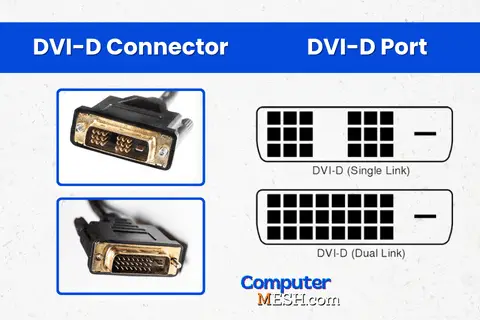These Cables are Compatible with 144Hz Display on Monitor
To enjoy gaming at 144Hz, three important pieces of hardware are required: a good graphics card, a 144Hz monitor, and a 144hz compatible data cable.
Not all data transfer cables are the same; there are different types, and it is necessary to choose the correct type and the version that supports 144hz in different resolutions, like 1080p, 1440p, and 4k.
Below, we will see all the relevant cable options for 144Hz.
What Type of Cables are Compatible with 144Hz?
Resolution | Refresh Rate | Cable Type |
FullHD (1920×1080) | 144Hz | DisplayPort 1.0 and higher HDMI 1.3 and higher Dual Link DVI-D |
QuadHD (2560x1440) | 144Hz | DisplayPort 1.2, and higher HDMI 2.0 and higher |
4k | 144Hz | DisplayPort 1.4 and higher HDMI 2.1 |
1. DisplayPort

DisplayPort cables are the popular option for achieving higher resolutions at high refresh rates without losing or compromising image quality. Gaming monitors that include a DisplayPort 1.2 port offer native support for 1080p@240Hz, 1440p@165Hz, and 4K@75Hz maximum.
With DisplayPort 1.3 and DisplayPort 1.4, you get enough bandwidth to play at 1440p@240Hz, 4K@120Hz, 5K@60Hz, and 8K@30Hz. The real difference about DisplayPort 1.4 is that it supports DSC (Display Stream Compression), allowing you to reach 4K@144Hz, 5K@120Hz, and 8K@60Hz, but with compression.
2. HDMI

Today, most monitors sizes, TVs, and graphics cards have at least an HDMI 1.4 connector, which is good enough to enjoy gaming at 1080p@144Hz, 1440p@75Hz, and 4K@30Hz.
For the HDMI 1.3 version, it is possible to play at 144Hz at 1080p, thanks to the bandwidth they offer, but color quality, chroma, compression, or resolution might be compromised.
Also, older monitors may limit reaching higher refresh rates, especially those from generations that are a few years old. So, it’s always a good idea to check if your monitor is compatible with the version you have.
A more advanced connection option is HDMI 2.0, which can run 1080p@240Hz and 1440p@144Hz uncompressed with 4:4:4 chroma subsampling. HDMI 2.0 can’t handle 4K at 144Hz, but with 4:2:0 chroma subsampling, about 120Hz is achieved.
With the arrival of the latest version, HDMI 2.1, you can run at 144Hz in almost all gaming resolutions, such as 1080p, 1440p, and 4K, all without compression or compromising quality. So, to enjoy the best gaming experience with HDMI running at 144Hz, it is necessary to have the latest generation cables.
3. Dual-Link DVI
DVI (Digital Visual Interface) is pretty common, but remember, it has differently designed connectors i.e DVI-A, DVI-D, DVI-I. Only dual-link DVI-I and dual-link DVI-D connectors can deliver resolutions of 1080p@144Hz and 1440p@75Hz.

You’ll still find some graphics cards, gaming and regular monitors with this connection. HDMI and DisplayPort are becoming increasingly popular and are taking over as the new standards.
Though DVI is still a worthy successor to VGA, it’s not the best fit for current games with 2K or 4K resolutions and high frame rates lacks in many features like Vysnc options, etc.
HDMI vs DisplayPort vs Dual-Link DVI for 144Hz?
Although it is possible to achieve about 144Hz in the three configurations, several factors come into play that make the DisplayPort port the most advanced and optimized technology for this purpose.
Dual-Link DVI technology has been obsolete in most options and does less as being a dual port.
HDMI, for its part, works very well for TVs and consoles, but it usually has limitations on most monitors than DP.
In most cases, DisplayPort is most suggested; it has an overwhelmingly high resolution and bandwidth that can be output, so there is no loss in choosing DisplayPort for those who value performance.
Lastly, it is necessary to use cables certified as “Premium High-Speed.” It is always better to use good quality cables, even though it may cost a little more. Poor-quality cables can cause problems such as picture flickering or reduced refresh rates. If that’s the case, consider trying a better quality cable.
Cable Adapters for 144 Hz
If your monitor only has a VGA or DVI port, you can use an adapter that converts VGA or DVI to HDMI. Active adapters are necessary here because DVI is an older analog standard, and passive adapters won’t work. The same applies to VGA connectors.
Even though your Monitor have a higher Hertz supported, good GPU with enough VRAM, it might be not always to get the expected Hz. It depends upon the quality of the adapter and signal conversion, and you may even face lag or tears while gaming.
With this you have got clear about the cables type and their version for displaying 144Hz on monitor.
[Related]